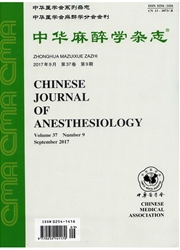

 中文摘要:
中文摘要:
目的探讨异氟醚预处理对大鼠肝脏缺血再灌注损伤的影响。方法成年雄性SD大鼠24只,体重180~220g,随机分为3组(n=8):假手术组(S组)吸入纯氧30min,间隔30min后仅开腹;肝脏缺血再灌注组(IR组)吸入纯氧30min,间隔30min后行肝脏缺血60min,再灌注4h;异氟醚预处理组(Iso组)吸入1.4%异氟醚30min,间隔30min后行肝脏缺血60min,再灌注4h。于再灌注4h时处死大鼠,留取肝脏及腹主动脉血5ml。测定血清谷丙转氨酶(ALT)和谷草转氨酶(AST)浓度,血清及肝组织匀浆上清液中肿瘤坏死因子α(TNF-α)的浓度,肝组织髓过氧化物酶(MPO)、超氧化物歧化酶(SOD)活性及丙二醛(MDA)含量,观察肝组织病理学改变。结果与S组比较,IR组、Iso组血清ALT、AST和TNF-α水平明显升高,肝组织TNF—α含量升高,肝组织MPO活性升高,MDA含量升高,SOD活性降低(P〈0.05或0.01),肝组织病理损伤明显;与IR组比较,Iso组血清ALT、AST和TNF-α水平降低,肝组织,TNF-α含量降低,肝组织MPO活性降低,MDA含量降低,SOD活性升高(P〈0.05或0.01),肝组织病理损伤程度减轻。结论1.4%异氟醚预处理可明显减轻大鼠肝脏缺血再灌注损伤,其机制可能与抑制TNF-α的释放、减少中性粒细胞在肝组织的浸润有关。
 英文摘要:
英文摘要:
Objective To investigate the effects of isoflurane preconditioning on hepatic ischemiareperfusion injury in rats. Methods Twenty-four adult male SD rats weighing 180-220 g were randomly divided into 3 groups ( n = 8 each) : group Ⅰ sham operation (S) ; group Ⅱ I/R and group m iso. The animals were anesthetized with intraperitoneal 3 % pentobarbital 40 mg/kg. Partial liver ischemia was produced by clamping the hepatic arteries supplying left lobe and middle lobe and portal vein for 60 min with atraumatic mini-clamp, followed by 4 h of reperfusion in I/R and Iso groups. In Iso group the animals inhaled 1.4% isoflurane for 30 min at 30 min before I/R. The animals were killed at 4 h of reperfusion. The liver was removed and 5 ml blood was taken from abdominal aorta for determination of (1) serum alanine aminotransferase (ALT) and aspartate aminotransferase (AST) activities ; (2) liver TNF- α content and serum TNF-α concentration ; (3) myeloperoxIdase (MPO) and SOD activities and MDA content in the liver and (4) microscopic examination. Results The serum ALT, AST and TNF-α levels; the MPO activity and MDA and TNF-α contents in the liver were significantly higher and SOD activity in the liver was significantly lower after hepatic I/R in I/R and Iso groups than in S group. Isoflurane preconditioning significantly ameliorated the deleterious effects of I/R and I/R-induced liver tissue damage. Conclusion Preconditioning with 1.4% isoflurane can significantly ameliorate hepatic I/R injury by inhibiting TNF-α release and reducing neutrophil infiltration in liver tissue.
 同期刊论文项目
同期刊论文项目
 同项目期刊论文
同项目期刊论文
 Isoflurane Preconditioning at Clinically Relevant Doses Induce Protective Effects of Heme oxygenase-
Isoflurane Preconditioning at Clinically Relevant Doses Induce Protective Effects of Heme oxygenase- Small Interference RNA Targeting TLR4 Gene Effectively Attenuates Pulmonary Inflammation in a Rat Mo
Small Interference RNA Targeting TLR4 Gene Effectively Attenuates Pulmonary Inflammation in a Rat Mo 期刊信息
期刊信息
